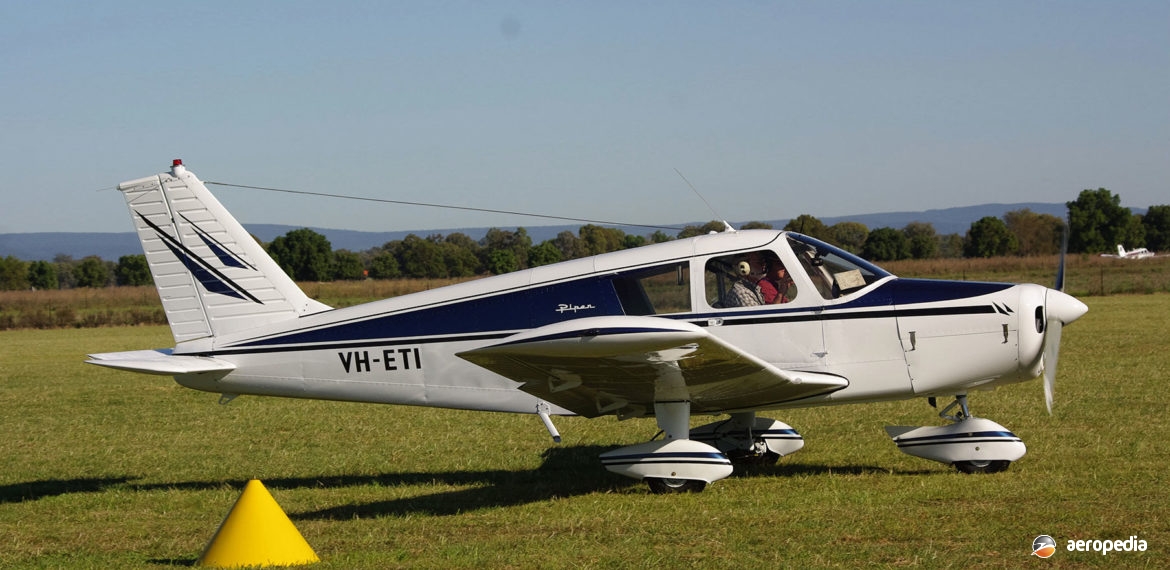Photograph:
Piper PA-28-140 Cherokee VH-ETI (c/n 28-25820) at Cowra, NSW in March 2012 (David C Eyre)
Country of origin:
United States of America
Description:
Touring and training monoplane
Power Plant:
One 112 kw (150 hp) Lycoming O-320-A2B four-cylinder horizontally-opposed air-cooled engine
Specifications:
- Wingspan: 9.14 m (30 ft 0 in)
- Length: 7.10 m (23 ft 3½ in)
- Height: 2.31 m (7 ft 7 in)
- Wing area: 14.86 m² (160 sq ft)
- Max speed: 228 km/h (142 mph)
- Max cruising speed: 214 km/h
- Long range cruising speed: 185 km/h (115 mph)
- Stalling speed: 84 km/h (52 mph)
- Initial rate of climb: 201 m/min (660 ft/min)
- Service ceiling: 4,358 m (14,300 ft)
- Take-off roll: 220 m (725 ft)
- Landing roll: 147 m (485 ft)
- Max range with no reserves with standard fuel: 1,094 km (680 miles)
- Max range with optional fuel: 1,529 km (950 miles)
- Empty weight: 535 kg (1,180 lb)
- Useful load: 342 kg (770 lb)
- Loaded weight: 975 kg (2,150 lb)
History:
Following on from the PA-24 Comanche series, the Cherokee, like the Cessna 150, 172 and 182 series, was designed to meet the requirements of training organisations and private owners for a cheap, economical and practical aircraft for private use. The aircraft was designed by John Thorp who had previously designed the Thorp T-11 series and the Fletcher FU-24 agricultural aircraft. Having only 1,200 parts, the aim was simplicity and the engine cowling, wing, fin, rudder and tips of the tailplane were built of fibreglass, the remainder of the aircraft being of metal construction, the fuel tanks being located in the leading edge of each wing. The aircraft had a fixed tricycle undercarriage. The wing had a laminar flow NACA 625-415 wing section with a maximum thickness about 40% aft of the leading edge. The wing was fitted with slotted flaps, manually operated.
The prototype of the Cherokee was powered by a Lycoming O-320 engine producing 119 kw (160 hp) and flew for the first time on 14 January 1960. Production immediately proceeded and deliveries began in February of the following year. Further development continued and these models have been dealt with elsewhere. A major change was made in 1964 when the PA-28-140 appeared, this being intended as a replacement for the PA-22 Colt and a competitor for the Cessna 150 then in use with training organisations. This model had a 104 kw (140 hp) Lycoming O-320 engine but this was soon replaced by the 112 kw (150 hp) variant of that engine.
The PA-28-140 was developed in subsequent years, these new models being the 140-4 in 1965 which was able to accommodate four adults with optional family seats in the rear of the aircraft, and the 140B in 1966 which had some detailed improvements. At that time the Piper facility at Vero Beach in Florida was constructing 11 aircraft each working day. Soon thereafter the 112 kw (150 hp) and 120 kw (160 hp) models were removed from the range but the PA-28-140 series continued with the 140B, 140C and 140D before it was renamed the Cherokee Cruiser in 1972.
At about that time a new variant known as the Flite Liner was introduced to the market for flying training schools, in particular the Flite Centres which were operated by Piper itself. However, by 1978 the PA-28-140 was starting to show its age and it was replaced on the production line with the PA-38 Tomahawk.
By the end of 2009 10,086 examples of the PA-28-140 had been delivered between the years 1964 and 1977, 300 examples of the PA-28-150 and 810 examples of the PA-28-160. Some 37,000 examples of the Cherokee series had been completed.

